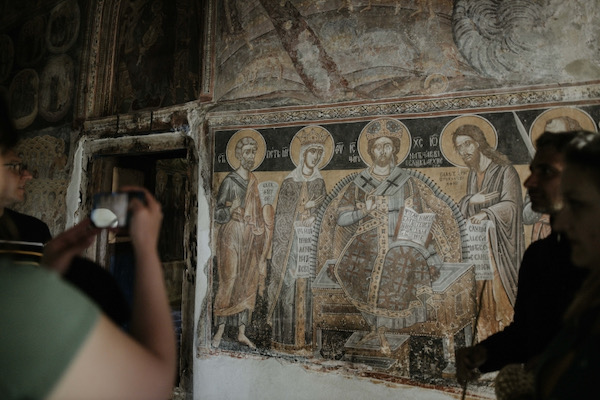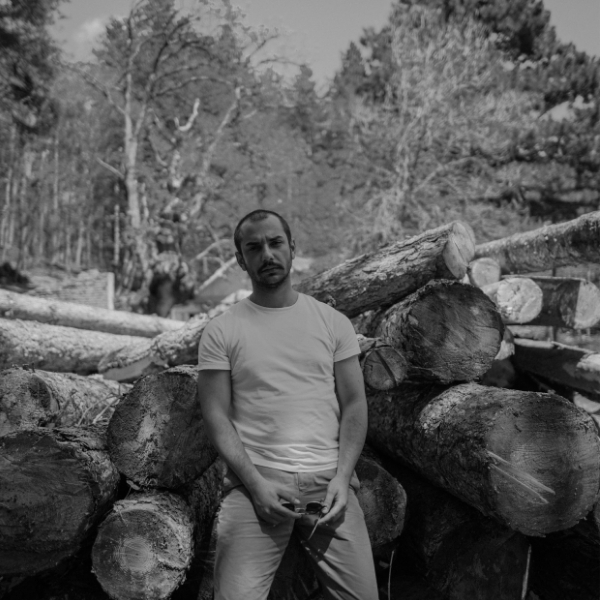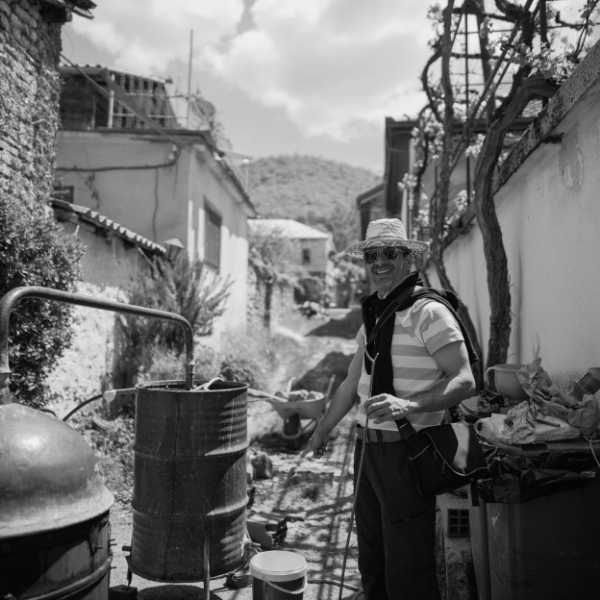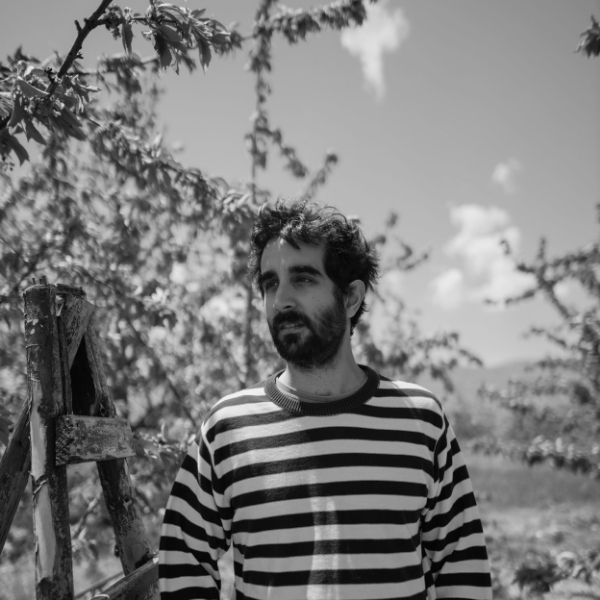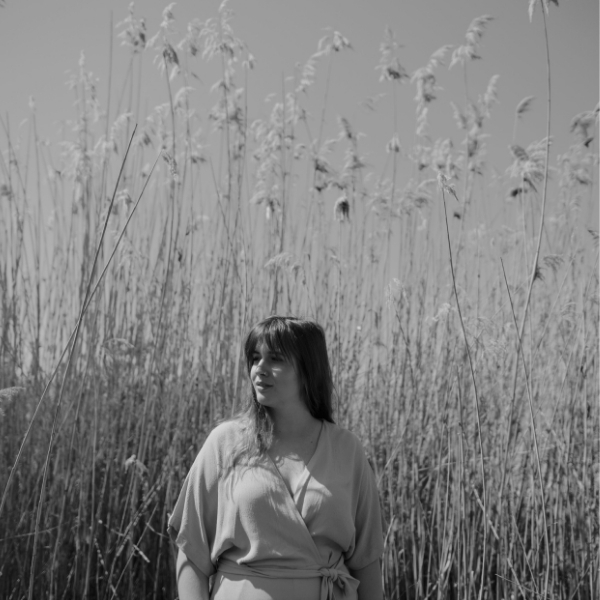Prespa is a cross-border region shared among North Macedonia, Albania, and Greece. The archaeological research shows that people have lived in the Prespa valley for over 4,000 years, but documented human presence doesn’t emerge until the 2nd century BC. Throughout the centuries, the region has been influenced and (trans)formed by many different cultures and people including Roman, Slavic, Greek, Macedonian, and Albanian. This comes as no surprise, since the region was encircled by the Via Egnatia, and was therefore situated on a hub of land routes. However, it has always been and still remains an isolated place with its own rhythms, identity, culture and traditions.
Considering the remoteness and sparseness of habitation, the amount of artistic and cultural activity in the area is surprising. In the Prespa region, there are numerous archaeological findings and sites from the Neolithic Age to the Byzantine and Post-Byzantine period, which are of high cultural and historical value. Another important feature of the area is the religious architecture and iconography, as represented in various churches and monasteries (with the artistic and cultural activity being also evident in their restoration and redecoration).
The Prespa region is equally important from a natural heritage perspective, and is nowadays a protected area, since it includes two of the highest tectonic lakes in the Balkans -the Great and Small Prespa Lakes- and hosts varied forms of life including many rare, endangered and endemic species.
Prespa is the region surrounding the Great and Small Prespa Lakes, and is shared by North Macedonia, Albania, and Greece. North Macedonia’s share of the region -in which we focus- is completely within the Resen Municipality, and contains the largest part of the Great Prespa Lake. It is bound by the Galičica National Park to the west, the Pelister National Park to the east, the borders with Albania and Greece to the south, and the northern parts of Resen Municipality to the north. This area consists of the villages of Konjsko, Stenje, Leskoec, Oteševo, Šurlenci, Volkoderi, Pokrvenik, Preljublje, Perovo, Drmeni, Ezerani, Podomočani, Grnčari, Rajca, Asamati, Kurbinovo, Pretor, Slivnica, Krani, Arvati, Štrbovo, Nakolec, Ljubojno, Brajčino, and Dolno Dupeni. And, according to the last census (2002), it is inhabited by over 4,500 people.
There are many ethnic communities living in the Prespa region, contributing to the overall cultural diversity of this cross-border area. Macedonians are the majority of the population (77%), while Albanians and Turks constitute the 22% and 1% of the population respectively. The villages of Arvati, Grnčari, Krani, and Nakolec are inhabited mostly by Albanians, while the larger Turkish communities are located on the northern part of Prespa towards Resen. In general, the Macedonians are Orthodox Christians, while Albanians and Turks are Muslims.
Prespa, like many other rural regions of North Macedonia, suffers from youth migration to cities and foreign countries. According to the last census (2002), the population is roughly half of that in 1981, and many villages are resided by elders. In the summertime, the number of people in the area increases, since many people return to their homes which belong to their families for generations.
Prespa is one of Europe’s deepest and oldest lakes, preserving a unique aquatic ecosystem of worldwide importance, with more than 200 endemic species. Due to its rare fauna and flora, the area was declared a Transboundary Park on 2 February 2000 (World Wetlands Day) with a joint Declaration by the Prime Ministers of Greece, North Macedonia and Albania, following a proposal from the Society for the Protection of Prespa and WWF Greece. In 2014, the Ohrid-Prespa Trans-Boundary Reserve between North Macedonia and Albania was added to UNESCO’s World Network of Biosphere Reserves. And it is worth noting that NASA has named one of the lakes of Titan after Lake Prespa.
Prespa has a long history of human habitation, as evidenced by archeological sites dating back to the Neolithic era (such as the Kallamas neolithic site), and Via Egnatia, which passed through the Prespa Lake valley during the Roman Empire era. Hellenistic, Roman and Early Christian sites can also be found on the Golem Grad island, while medieval churches and monasteries are scattered around the region.
Probably, two of the most popular cultural monuments in Prespa are the Church of St. George, a 12th-century Orthodox aisleless church near the Kurbinovo village, which is known for its frescoes (and is currently in the Tentative List of North Macedonia to be considered for inclusion in UNESCO’s World Heritage List); and the Saraj, a historic neoclassical estate in Resen, built in the early 20th century by the local Ottoman bey, Ahmed Niyazi Bey. While this saraj (“palace” in Turkish) testifies the Ottoman occupation in the region, its architectural style is strongly influenced by the French-style mansions, making it unique in North Macedonia. In any case, the Ottoman-era village architecture is still visible in almost every village of Prespa, which comes as no surprise, considering that the territory of the present-day North Macedonia was part of the Ottoman Empire for over 500 years.
The inhabitants of Prespa participated actively in the Ilinden Uprising of 1903, and suffered severe attacks from the Ottomans. For example, in the Brajčino village, 27 people were killed, while 77 houses and all but 2 churches were burnt down. The Ottoman rule ended in 1912, when the Kingdom of Serbia took control of the area and partitioned it. During World War I, the region was occupied by Bulgaria, and the Macedonian front ran through the Prespa region. After the war, Prespa was still part of the Kingdom of Serbia. However, during World War II, it fell under the Italian protectorate of Albania, and then, for a short period of time, under the Bulgarian fascists. After the National Liberation War, Prespa was part of the People’s Republic of Macedonia -renamed to Socialist Republic of Macedonia in 1963- under the Socialist Federal Republic of Yugoslavia. And in 1991, it became part of the independent Republic of Macedonia -renamed to Republic of North Macedonia in February 2019, after the signing of the Prespa Agreement in July 2018.
Orthodox Christianity has played and still plays a significant role in the shaping of the local traditions and cultural identities of the Prespa region. This role is manifested by:
- the existence of many churches and monasteries, which are highly valued for their architectural styles, and all kinds of fine and applied arts related to iconography and liturgy; and
- the performing of various festivities — from celebrating the Epiphany (“Vodici”, 19-20 January) and the Nativity of St. John the Baptist (“Ivanden”, 5-7 July) to harvesting apples during the Apple Picking Day (27 September), which coincides with the celebration of the Elevation of the Holy Cross (“Krstovden”).
The celebration of the birth of St. John the Baptist -a.k.a. “Ivanden”– consists of a 3-day ritual practice, which used to be a common one in almost all of the settlements in the region. However, nowadays, it is performed only in Resen. Of course, this ritual has been transformed over time, but remains rich in meaning and complex in structure, and retains its main element, the “Ivanka” doll, which is inscribed on the national list of protected intangible cultural heritage of North Macedonia.
One other important manifestation of the local traditions in Prespa are the two folk costumes from “Gorna” (“Upper”) and “Dolna” (Lower) Prespa that were worn in the villages along the shores of the lake. Above all, the product of domestic textile manufacture, these costumes are characterised by richness and ornamentation. The women’s costumes are especially interesting, because they are decorated with embroidery, which is characteristic in its forms, technically complex and of picturesque colours, giving special expression and distinction to these costumes, and making them the main bearer of this kind of traditional artistic creation.
As evidenced by the archaeological findings, pottery was developed in Resen in the past, and is still present thanks to the Resen Ceramics Colony. This colony is an international art event held every year in Resen and Otesevo, and it is home to many famous potters from all over the world. It was established in 1973, in order to preserve the specific traditional work of the potters from Resen, and to enable the creation of contemporary artistic works in ceramics. In the beginning, the artworks were of Yugoslav character, but later on, they grew into a manifestation of international character. The Resen Ceramics Colony is a typical example of dynamic preservation of traditions and of international recognition. With hard work and support from the local government, it became a member of the International Academy of Ceramics, which is affiliated with UNESCO. And so far, it has hosted more than 200 artists from all over the world, and has created a collection of more than 800 artworks. Around 300 of these pieces are now exhibited in the Saraj (see above: History and Cultural Heritage).
It is worth noting that, apart from the Resen Ceramics Colony, the Saraj today also houses the Dragi Tozija House of Culture, the Keraca Visulčeva Gallery, and a city library. The Dragi Tozija House of Culture is a branch of the Museum of the Republic of North Macedonia in Skopje, and it hosts plays, literary readings, and other cultural events. The Keraca Visulčeva Gallery is a permanent exhibition of the works of Keraca Visulčeva (realist and post impressionist painter), which opened after her request before her death. The city library has existed in the Saraj since the 1940s, and today, it contains over 31,000 books.
Although located in Lake Ohrid, it is worth mentioning the Museum on Water in the Bay of Bones, due to its special character. This museum represents a reconstruction of a pile-dwelling settlement, identical to the remains of the underwater archaeological site Plocha Michov Grad. According to archaeological research, this prehistoric (palafitte) settlement dates back to the Late Bronze and Early Iron Ages (1200-700 B.C.), and used to spread on a surface of about 8500 sqm. During past underwater archaeological activities (1997-2005), researchers registered around 6,000 remains of wooden piles at the bottom of the lake at a depth of 3-5 meters (probably supporting a common wooden platform, on which there were around 20 prehistoric residential huts, also built of wood). In addition, they collected numerous Bronze and Iron Age artefacts (e.g. ceramic vessels, stone and flint objects), along with a multitude of fragments of animal bones, including such that have been used as tools. The settlement was reconstructed from 2007 to 2008. And today, the site Plocha Michov Grad is a museum complex which includes the reconstructed palafitte settlement over the waters of the lake, a restored Roman military fortification (castrum) at the highest plateau of the hill Gradishte, showcases with museum objects, and facilities for underwater tourism.
Catsadorakis, G., Papadopoulou, E., Petrakos, M., Koutseri I. (2018). “Status of Fisheries at Megali Prespa Lake and Mikri Prespa Lake, Greece, Based on a Census of Fishermen’s Opinions”. Environment and Ecology Research, 6 (6): 583-592. DOI: 10.13189/eer.2018.060608 (available online).
European Commission (March 2020). “Republic of North Macedonia: Population: Demographic Situation, Languages and Religions” (available on Eurydice).
Institute for Protection of Monuments of Culture and Museum – Ohrid, Project: Museum on Water “Bay of Bones”. Reconstruction of a Prehistoric Pile Dwelling Settlement (available online).
Muslli, E. (2015). “The Cultural Heritage of the Great Prespa Region”, Academic Journal of Business, Administration, Law and Social Sciences, 1 (1): 160-165 (available online).
Naumoski, Z. (2012). Baseline Study and Strategic Plan for Development of Prespa Region (available online).
Papayannis, T. (2008), Action for Culture in Mediterranean Wetlands, Athens: Med-INA (available online).
Regional Rural Development Standing Working Group in South Eastern Europe
Stojanova, M. (2013). Ivanden, Celebrations in Resen. Bitola: NI Institute and Museum Bitola (available on academia.edu).
Research on local history, cultural heritage and traditions: Katerina Popovska
Research on open access repositories and illustration: Revekka Kefalea
Review and semantic enrichment: Mina Karatza, Nikos Pasamitros, Revekka Kefalea
Last update: 25 June 2021.
During the Prespa Art Residency (May 2021), the artists-in-residence stayed in the region, and visited many important natural and cultural sights (such as the Golem Grad island, and the Saraj building) which inspired their artworks. In addition, they drew inspiration from the natural environment, the fauna and the flora of the lake, the fishermen’s life, the histories of the people living in the villages around the lake, and the different traditions and customs they nurture, the religious monuments and their cultural and historical values, as well as the traditional patterns that are typical of the region.
The first Prespa Local Arts Exhibition took place from 21 to 22 June 2021, and was hosted in Club Jagoda in Bitola. Located next to the train station in Bitola, Club Jagoda is a milti-purpose hall which functions as a night club, and also hosts events, exhibitions and other projects.
The second Prespa Local Arts Exhibition took place from 25 to 26 June 2021, and was hosted in the Multimedia Center “Mala Stanica”. Located in the National Gallery of North Macedonia, in the structure of contemporary Skopje, this multimedia center has a specific historical background, which -in a characteristic way- connects different eras and is considered as “industrial heritage”.





